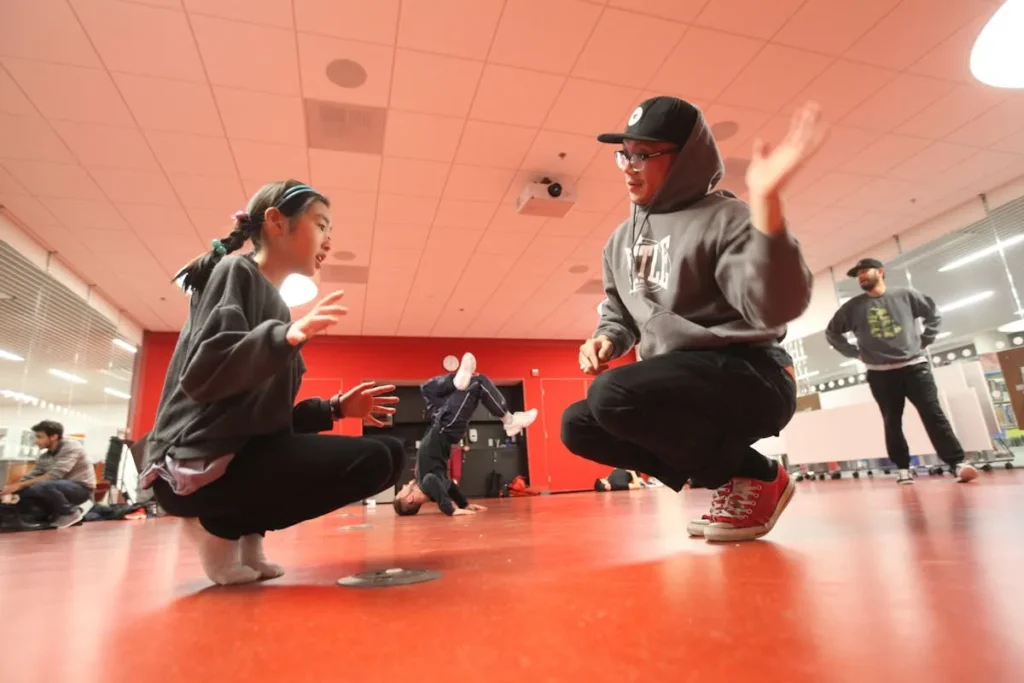Is breakdancing safe for children?

Is breakdancing safe for children? Breakdancing is an exciting and energetic physical activity that can be incredibly beneficial for children. It helps develop motor skills, coordination, strength, and confidence, but like any intense physical activity, it's important to take precautions to ensure safety and avoid injury. Below are some key tips to make breaking safe and fun for little ones:
1. Perform a proper warm-up
Before beginning any breakdancing session, it's essential to warm up properly to prepare your muscles and joints. Dynamic stretches, such as gentle jumping or circular movements of the arms, wrists, hips, shoulders, knees, and neck, help improve flexibility and reduce the risk of injury.
2. Supervision by a qualified instructor
Breakdancing involves a series of complex movements that require technique and body control. It's essential that children learn these moves from a qualified instructor who can guide them properly and correct their posture and technique.
**Advice:** An experienced coach can help children avoid technical errors that can lead to poor posture or dangerous movements.
3. Use of appropriate protective equipment
Although not mandatory, the use of certain protective equipment can be a good idea, especially for more advanced movements. Caps, wrist guards, knee pads, or elbow pads can offer an additional layer of safety and comfort while children practice.
**Advice:** When children are learning movements like **freezes** (balance on the head, hands, elbows, shoulders, etc.), the use of head and elbow protection is especially useful.
4. Gradual progression in movements
It is important that children do not attempt advanced moves too early. Breakdancing should be learned in stages, starting with basic moves such as the **Top Rock**, **Footwork**, y **Freezers**, before moving on to more complex exercises, such as the **Windmill** or the **Swipes**, which require more strength, control, and agility from your body.
**Advice:** Movements should be mastered properly in their simplest form before progressing to more difficult variations. This reduces the risk of overuse injuries.
5. Choose a suitable place to practice
The surface on which breakdancing is practiced is crucial. To avoid falls or twists, children should dance in a place with enough space and a safe surface, such as a mat or rubber floor. Avoid hard surfaces, such as cement, especially when starting out, especially when practicing moves that involve falls or quick spins. The most important thing is that breakdancing is safe for children, especially at the beginning.
**Advice:** If possible, use mats to soften the impact of your movements.
6. Listen to your body and avoid overexertion
It's easy to get excited about learning new movements, but it's important for children to learn to listen to their bodies and avoid overexertion. If they feel pain, fatigue, or discomfort, they should take a break. Adequate rest is key to preventing overuse injuries.
**Tip:** Encourage children to take regular breaks to avoid burnout and to stop if they feel pain anywhere in their body.
7. Promote proper posture
Many of the moves in breakdancing require proper posture to avoid injuries, especially in the back, wrists, and neck. Poor posture can cause tension and long-term problems. That's why it's important for children to be aware of their posture when practicing moves like freestyles or spins.
**Tip:** The Breaking coach should correct any poor posture immediately to prevent the child from developing bad habits.
8. Set limits and don't rush
Breakdancing is a gradual learning process, and each child develops at their own pace. Make sure children don't pressure themselves into performing complex moves too quickly. Progress should be a continuous process, with no rush and consistent training. 4-5 days a week is recommended.
**Advice:** Fostering patience and celebrating small achievements is key to maintaining motivation and confidence.
9. Stretching and cooling down at the end of the session
At the end of a breakdancing session, stretching is essential to prevent muscle injuries. Children should gently stretch the muscles they've worked the most, such as their legs, shoulders, and back. This helps reduce stiffness and promotes muscle recovery.
**Advice:** A 5-10 minute cool-down is essential to prevent injury and maintain flexibility.
10. Maintain adequate hydration
Breakdancing is a physically demanding activity, so children should stay hydrated during practice and take breaks when they're tired to drink water. Dehydration can increase the risk of cramps and fatigue.
**Advice:** Make sure children always have water available and drink regularly during practice.
—
Conclusion: Breakdance Safely and Have Fun!**
Breaking can be an excellent form of exercise, fun, and development for children. By following these tips and practicing safely, children can enjoy all the benefits of this incredible discipline while minimizing the risk of injury. Always remember to ensure the environment is safe, that practice is gradual, and that children are supervised by a good coach.
With patience and proper care, breakdancing can be a fun and enriching experience for little ones!
After learning a little more in this article, do you think breakdancing is safe for children? If you want to know at what age to start breaking dancing, you can read our article. here!
—
Ready for your child to get started in the world of breakdancing? Contact us for more information about our classes and begin their dance journey today!